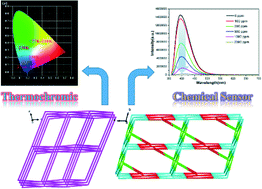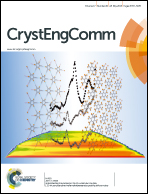Structural variability, unusual thermochromic luminescence and nitrobenzene sensing properties of five Zn(ii) coordination polymers assembled from a terphenyl-hexacarboxylate ligand†
Abstract
Reactions of the terphenyl-hexacarboxylate ligand [1,1′;4′,1′′]terphenyl-3,5,2′,5′,3′′,5′′-hexacarboxylic acid (H6L) with Zn(NO)3 in the mixed solvents under low-temperature solvothermal conditions afforded five new coordination networks, namely, {[Me2NH2]2[Zn5(L)2(H2O)4]·16H2O}n (1), {[Me2NH2][Zn(H3L)(H2O)]·C2H5OH·5H2O}n (2), {[Me2NH2]2[Zn2(L)(H2O)2]·2DMF·2H2O}n (3), {[Zn4(L)(COO)2(DMF)2(H2O)2]·2C2H5OH·2DMF·2H2O}n (4), and {[Zn4(L)(DMF)4(C2H5OH)(H2O)](OH)2·DMF·2H2O}n (5) (DMF = N,N-dimethylformamide). Compounds 1 and 3–5 possess 3D frameworks, while compound 2 exhibits a 2D grid layer network. Photoluminescence properties of these five compounds have been investigated in solid state at room temperature and low temperature. These five compounds exhibit two kinds of emission modes at room temperature, and compounds 3–5 turn out to have interesting responses to temperature. The sensing properties of compound 1 also have been explored, which show high selectivity and sensitivity to trace amounts of nitrobenzene.


 Please wait while we load your content...
Please wait while we load your content...